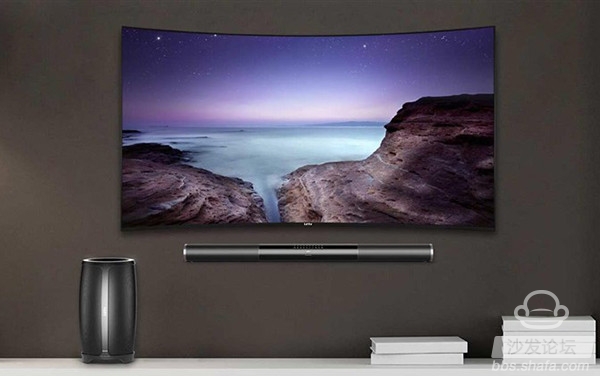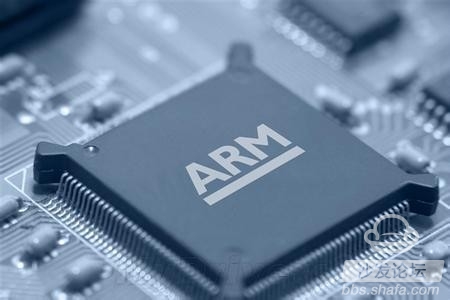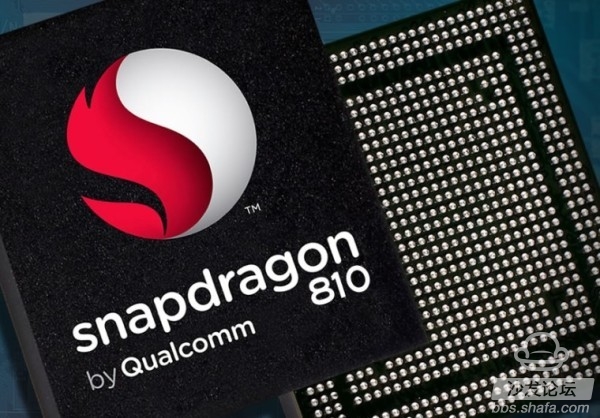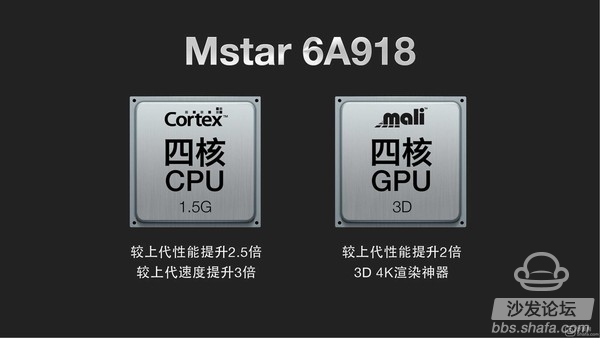In the field of smart phones, Qualcomm is a typical representative of the performance of mobile phone processors. For smart TVs, which is also a system running Android, does Qualcomm still have such a strong position? In fact, on the contrary, in the smart TV market, the Qualcomm processor appears to be so weak that it is the name you almost never heard. Some people say that TV can do a good job on the screen, but it is now the era of smart TV.

Having contacted many mobile phones and smart TV conferences, we will find an interesting phenomenon carefully. On smart phones, major mobile phone manufacturers will undoubtedly publicize the use of Qualcomm X-core high-performance processors because For many people, whether or not the adoption of Qualcomm's processors will be an important factor in whether they will pay for them; on smart TVs, you will only see the word "64-bit quad-core Cortex-A53 processor." As for the brand of the processor, it is almost never mentioned, which also makes many consumers do not know the TV chip manufacturers or mistakenly believe that Qualcomm still occupies a dominant position.
Qualcomm flagship dragon 810 "unsatisfied with soil and water"
Commonly found on mobile phones are cell phone chips produced by Qualcomm, MediaTek, Samsung, and Hass. TVs generally use powerful TV decoding chips such as Morning Star, Jing Chen, and Rockchip. Nowadays, most smart TVs use these unknown chips. Since it is also an Android smart system, isn't it better to use a high-performance Qualcomm processor on TV? Some people think so, such as LeTV.

On December 22, 2015, LeTV officially released the fourth-generation super TV. The most noticeable is that the chip it carries is the Qualcomm Snapdragon 810 processor. What is Xiaolong 810? In 2015, Sony, LG and other mobile phone industry giants were pitted by it. One of the handsets equipped with Xiaolong 810 became a “hands warmerâ€, and Xiaolong 810 was also successfully selected as the most expensive and hot processor in history.

Good return to the topic, Le Shi put the dragon 810 hot potato into the TV, it will inevitably face its fever. However, compared to mobile phones, we do not hold the television. In fact, it is still good. The biggest problem with the application of the 810 in television is not the heating, but its own positioning. Smart TVs focus on video playback capabilities, followed by performance. Compared to the choice of traditional TV chips and Qualcomm, traditional TV chips are unquestionable in video decoding capabilities. Although performance is weak and Qualcomm is sufficient, it is enough to meet the daily needs. The most important thing is that in this era of cost-cutting, Qualcomm is not a Good choice. After all, the average TV chip is tens or even a dozen yuan, and Qualcomm’s flagship processor purchase price is a few hundred.

Summary: In addition, Qualcomm Snapdragon 810 is a mobile phone processor, there are two main problems in the application of television: one is the TV does not require the baseband, in addition to WIFI, Bluetooth does not require other communication functions; the second is 4K resolution Support, As we all know, mobile phones are mainly used as communication tools, and the requirements for video decoding capabilities are not so high. Until the second half of 2015, Sony introduced the world's first 4K screen mobile phone, using the Snapdragon 810 processor. Qualcomm did not enter Xiaolong 810 into the smart TV market. In addition to its own cost-effectiveness, there may be other reasons.
Why is Qualcomm unreliable?
Some people say that since it is a chip used in mobile phones, it is not feasible to take advantage of the Snapdragon 810. The smart TV market is not much smaller than the mobile phone market, Qualcomm naturally will not have no sensation. Previously, Qualcomm had released TV chips Xiaolong 600 and Xiaolong 802. Naturally, there was no doubt about its performance. However, Xiaolong 802 was halted after 5 weeks, just because Xiaolong 802 was not as expected by Qualcomm. Regain the advantages of the TV market.

However, in terms of performance, Qualcomm has to say that it is second, naturally, no one can confidently call it first. But in video decoding, Qualcomm seems to have not really prepared for the smart TV market. Video decoding is divided into hard decoding and soft decoding. Soft decoding is just like on a computer. Pure computing performance is used to process video decoding. The stronger the CPU performance is, the better the effect of video playback is. Hard decoding uses specialized hardware for video decoding. For example, a GPU for a graphics card can be used on a computer. In a mobile phone, a dedicated decoding circuit is generally added to the main chip. Soft decoding has advantages in compatibility and image effects, but the problems of high power consumption have not been solved, hard decoding power consumption is extremely small, and the cost is extremely low (compared with the equivalent decoding capability of the CPU).

Mobile phones and TV chips are ARM-based chips, and the three methods of encapsulating CPUs, GPUs, and decoding circuits are commonly used. Because the CPU performance of the ARM architecture cannot be compared with the CPU of the desktop, even the fastest quad-core and eight-core ARM CPUs have very limited performance and cannot play high-stream high-definition video smoothly. At this time, the dedicated decoding circuit helps a lot.
Qualcomm's processor, integrated Adreno series GPU, which must be extra plug-in 4K solution DSP chip, will make the 4K playback normal, external DSP chip after the Xiaolong 600 does not support 4K playback The inconvenience of the circuit scheme is complicated and the cost is increased, which is not necessary for the television experience.

While MStar, Crystal Morning and other TV chips are not as good as Qualcomm's processors in terms of performance alone, they are still more than enough to cope with daily usage needs. But most importantly, these chips incorporate a dedicated circuit that supports H.2654K hard decoding. No H.265 hard decoding to talk about 4K are naked rogue, this chip not only meets the needs of the CPU performance, hardware decoding has obvious advantages, the most important is the cost-effective enough, which also makes it impossible for Qualcomm to find.
Summary: The advantages of Qualcomm's solution lie in the integration of baseband rather than decoding technology, which is the key to mobile phones. Therefore, Qualcomm can become the overlord of mobile phone processors, but not for smart TVs. Now that 4K TV has become mainstream, it cannot support full 4K format hard decoding, even if it is not a true 4K TV.
TV, mobile phone chip will eventually become one
As said before, the big cake of smart TV, it is impossible to say that Qualcomm has no heart. Baseband integration is Qualcomm's biggest advantage, but it is totally useless for TVs. Although its performance is powerful, it has been dragged down by video decoding and insufficient cost-effectiveness. When 4K handsets appear, more and more manufacturers will gradually keep up, and Qualcomm will further strengthen its support for 4K decoding. By that time, entering the TV chip market will be in vain.

Traditional television chip makers are still enjoying a good time, but smart TVs have gradually highlighted the trend of stacking hardware performance. These traditional brand TV chips have already fallen behind in size in performance compared to mobile phone chips, when the performance of TV chips Already unable to exert enough hardware level, TV manufacturers will begin to look for new partners. On the other hand, Qualcomm Snapdragon 810 is the first mobile phone chip that can completely decode H.264 (AVC) and H.265 (HEVC) format video. This means that the mobile TV chip gradually converges, and the side reveals the high-pass hidden. His ambitions, so it is not unreasonable to say that LeTV put Xiaolong 810 hot potato in the TV, but Qualcomm is not ready yet.

Perhaps everyone has gradually discovered that even if the mainstream TV chips such as Morningstar (MStar) have inherent advantages in video decoding, the decline in performance has gradually become apparent. Without a processor with sufficient performance and stability, there are no solutions to the fundamental problems that can be solved, such as the stuck smart TV and the crash. Qualcomm has inherent advantages in processor performance. Xiaolong 810 has already let TV manufacturers see confidence. In the coming Xiaolong 820 and even Xiaolong 830, Qualcomm looks like sooner or later it will launch a perfect compatible mobile phone and smart TV. End product.
Summary: Although the price/performance ratio is still important, the price war can only be played for a while. Consumers still pay more attention to the experience. The pace of replacement of smart TVs is already accelerating. Like computers and mobile phones, hardware stacking and performance competition will also be the only way to go. Under this premise, if Qualcomm solves the shortcomings of video decoding, TV manufacturers are certainly willing to choose more powerful partners. Morningstar, Jingchen, Rockchip and other chip makers are starting to think in peacetime, although they currently occupy the vast majority of the market, sitting on the most powerful TV chip, but can not sit idly by high pass to grab business, it is true that Qualcomm will successfully mobile phone , TV chip combo, traditional TV chip manufacturers should come up with what kind of competitiveness? Cost-effective? Ha ha

Summary: At present, Qualcomm’s position in the smart TV market is almost negligible. The most basic video decoding cannot be achieved. No matter how good the performance is, it will not be excused. However, with the advent of Qualcomm Snapdragon 810, regardless of its original intention is to support 4K on the phone or something, at least let the mobile phone chip applied to the TV chip becomes possible (although it would have been possible), in the future Snapdragon 820, 830, etc. We will finally see the birth of a high-performance chip that is compatible with both TVs and mobile phones. This is when Qualcomm officially enters the smart TV market.

Having contacted many mobile phones and smart TV conferences, we will find an interesting phenomenon carefully. On smart phones, major mobile phone manufacturers will undoubtedly publicize the use of Qualcomm X-core high-performance processors because For many people, whether or not the adoption of Qualcomm's processors will be an important factor in whether they will pay for them; on smart TVs, you will only see the word "64-bit quad-core Cortex-A53 processor." As for the brand of the processor, it is almost never mentioned, which also makes many consumers do not know the TV chip manufacturers or mistakenly believe that Qualcomm still occupies a dominant position.
Qualcomm flagship dragon 810 "unsatisfied with soil and water"
Commonly found on mobile phones are cell phone chips produced by Qualcomm, MediaTek, Samsung, and Hass. TVs generally use powerful TV decoding chips such as Morning Star, Jing Chen, and Rockchip. Nowadays, most smart TVs use these unknown chips. Since it is also an Android smart system, isn't it better to use a high-performance Qualcomm processor on TV? Some people think so, such as LeTV.

The first smart TV with Qualcomm Snapdragon 810 processor
On December 22, 2015, LeTV officially released the fourth-generation super TV. The most noticeable is that the chip it carries is the Qualcomm Snapdragon 810 processor. What is Xiaolong 810? In 2015, Sony, LG and other mobile phone industry giants were pitted by it. One of the handsets equipped with Xiaolong 810 became a “hands warmerâ€, and Xiaolong 810 was also successfully selected as the most expensive and hot processor in history.

Xiaolong 810 video decoding capability is not fully exposed
Good return to the topic, Le Shi put the dragon 810 hot potato into the TV, it will inevitably face its fever. However, compared to mobile phones, we do not hold the television. In fact, it is still good. The biggest problem with the application of the 810 in television is not the heating, but its own positioning. Smart TVs focus on video playback capabilities, followed by performance. Compared to the choice of traditional TV chips and Qualcomm, traditional TV chips are unquestionable in video decoding capabilities. Although performance is weak and Qualcomm is sufficient, it is enough to meet the daily needs. The most important thing is that in this era of cost-cutting, Qualcomm is not a Good choice. After all, the average TV chip is tens or even a dozen yuan, and Qualcomm’s flagship processor purchase price is a few hundred.

Xiaolong 810 on the smart TV "acclimatized"
Summary: In addition, Qualcomm Snapdragon 810 is a mobile phone processor, there are two main problems in the application of television: one is the TV does not require the baseband, in addition to WIFI, Bluetooth does not require other communication functions; the second is 4K resolution Support, As we all know, mobile phones are mainly used as communication tools, and the requirements for video decoding capabilities are not so high. Until the second half of 2015, Sony introduced the world's first 4K screen mobile phone, using the Snapdragon 810 processor. Qualcomm did not enter Xiaolong 810 into the smart TV market. In addition to its own cost-effectiveness, there may be other reasons.
Why is Qualcomm unreliable?
Some people say that since it is a chip used in mobile phones, it is not feasible to take advantage of the Snapdragon 810. The smart TV market is not much smaller than the mobile phone market, Qualcomm naturally will not have no sensation. Previously, Qualcomm had released TV chips Xiaolong 600 and Xiaolong 802. Naturally, there was no doubt about its performance. However, Xiaolong 802 was halted after 5 weeks, just because Xiaolong 802 was not as expected by Qualcomm. Regain the advantages of the TV market.

Hard decoding is more suitable for mobile phones and smart TVs
However, in terms of performance, Qualcomm has to say that it is second, naturally, no one can confidently call it first. But in video decoding, Qualcomm seems to have not really prepared for the smart TV market. Video decoding is divided into hard decoding and soft decoding. Soft decoding is just like on a computer. Pure computing performance is used to process video decoding. The stronger the CPU performance is, the better the effect of video playback is. Hard decoding uses specialized hardware for video decoding. For example, a GPU for a graphics card can be used on a computer. In a mobile phone, a dedicated decoding circuit is generally added to the main chip. Soft decoding has advantages in compatibility and image effects, but the problems of high power consumption have not been solved, hard decoding power consumption is extremely small, and the cost is extremely low (compared with the equivalent decoding capability of the CPU).

Mobile phones and smart TV chips are ARM structures
Mobile phones and TV chips are ARM-based chips, and the three methods of encapsulating CPUs, GPUs, and decoding circuits are commonly used. Because the CPU performance of the ARM architecture cannot be compared with the CPU of the desktop, even the fastest quad-core and eight-core ARM CPUs have very limited performance and cannot play high-stream high-definition video smoothly. At this time, the dedicated decoding circuit helps a lot.
Qualcomm's processor, integrated Adreno series GPU, which must be extra plug-in 4K solution DSP chip, will make the 4K playback normal, external DSP chip after the Xiaolong 600 does not support 4K playback The inconvenience of the circuit scheme is complicated and the cost is increased, which is not necessary for the television experience.

MStar TV chip supports full 4K format hard decoding
While MStar, Crystal Morning and other TV chips are not as good as Qualcomm's processors in terms of performance alone, they are still more than enough to cope with daily usage needs. But most importantly, these chips incorporate a dedicated circuit that supports H.2654K hard decoding. No H.265 hard decoding to talk about 4K are naked rogue, this chip not only meets the needs of the CPU performance, hardware decoding has obvious advantages, the most important is the cost-effective enough, which also makes it impossible for Qualcomm to find.
Summary: The advantages of Qualcomm's solution lie in the integration of baseband rather than decoding technology, which is the key to mobile phones. Therefore, Qualcomm can become the overlord of mobile phone processors, but not for smart TVs. Now that 4K TV has become mainstream, it cannot support full 4K format hard decoding, even if it is not a true 4K TV.
TV, mobile phone chip will eventually become one
As said before, the big cake of smart TV, it is impossible to say that Qualcomm has no heart. Baseband integration is Qualcomm's biggest advantage, but it is totally useless for TVs. Although its performance is powerful, it has been dragged down by video decoding and insufficient cost-effectiveness. When 4K handsets appear, more and more manufacturers will gradually keep up, and Qualcomm will further strengthen its support for 4K decoding. By that time, entering the TV chip market will be in vain.

Qualcomm Snapdragon 810 can hard-solve some 4K videos
Traditional television chip makers are still enjoying a good time, but smart TVs have gradually highlighted the trend of stacking hardware performance. These traditional brand TV chips have already fallen behind in size in performance compared to mobile phone chips, when the performance of TV chips Already unable to exert enough hardware level, TV manufacturers will begin to look for new partners. On the other hand, Qualcomm Snapdragon 810 is the first mobile phone chip that can completely decode H.264 (AVC) and H.265 (HEVC) format video. This means that the mobile TV chip gradually converges, and the side reveals the high-pass hidden. His ambitions, so it is not unreasonable to say that LeTV put Xiaolong 810 hot potato in the TV, but Qualcomm is not ready yet.

The performance of the most powerful TV chip is still against the Snapdragon 810
Perhaps everyone has gradually discovered that even if the mainstream TV chips such as Morningstar (MStar) have inherent advantages in video decoding, the decline in performance has gradually become apparent. Without a processor with sufficient performance and stability, there are no solutions to the fundamental problems that can be solved, such as the stuck smart TV and the crash. Qualcomm has inherent advantages in processor performance. Xiaolong 810 has already let TV manufacturers see confidence. In the coming Xiaolong 820 and even Xiaolong 830, Qualcomm looks like sooner or later it will launch a perfect compatible mobile phone and smart TV. End product.
Summary: Although the price/performance ratio is still important, the price war can only be played for a while. Consumers still pay more attention to the experience. The pace of replacement of smart TVs is already accelerating. Like computers and mobile phones, hardware stacking and performance competition will also be the only way to go. Under this premise, if Qualcomm solves the shortcomings of video decoding, TV manufacturers are certainly willing to choose more powerful partners. Morningstar, Jingchen, Rockchip and other chip makers are starting to think in peacetime, although they currently occupy the vast majority of the market, sitting on the most powerful TV chip, but can not sit idly by high pass to grab business, it is true that Qualcomm will successfully mobile phone , TV chip combo, traditional TV chip manufacturers should come up with what kind of competitiveness? Cost-effective? Ha ha

Qualcomm or will promote the integration of TV mobile phone chips
Summary: At present, Qualcomm’s position in the smart TV market is almost negligible. The most basic video decoding cannot be achieved. No matter how good the performance is, it will not be excused. However, with the advent of Qualcomm Snapdragon 810, regardless of its original intention is to support 4K on the phone or something, at least let the mobile phone chip applied to the TV chip becomes possible (although it would have been possible), in the future Snapdragon 820, 830, etc. We will finally see the birth of a high-performance chip that is compatible with both TVs and mobile phones. This is when Qualcomm officially enters the smart TV market.
Double Sided Pcb,Double-Layer Circuit Boards,Double-Layer Pcb Circuit Board,Double Sided Circuit Board
Shenzheng Weifu Circuit Technology Co.Ld , https://www.viafoem.com